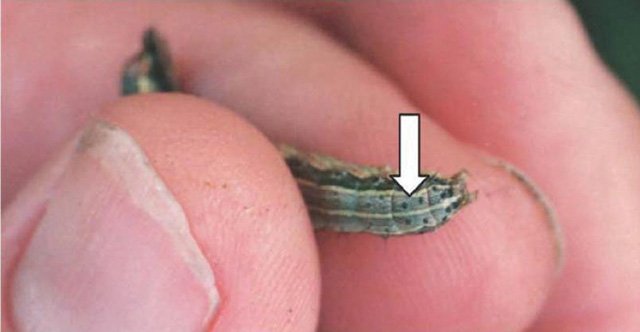They're coming, marching across croplands, pastures, golf courses and residential yards with a voracious appetite.
Army worms, named for their propensity to travel in phalanxes of thousands, are infesting west-central Arkansas earlier this year than ever, according to entomologists with the University of Arkansas, Fayetteville.
"They'll eat a whole yard in a night," said Tyler Little, owner of Lakeside Landscaping in Hot Springs. "I've seen it. You can see them. It looks like the yard is moving."
Kelly Loftin, an entomologist with the Cooperative Extension Service of the University of Arkansas System's Agriculture Division, said he expects the infestation to be as bad, if not worse, than last year. A mild, cool winter, coupled with a moist spring, has provided a favorable climate for the army worms to multiply.
Usually, the worms begin appearing in mid-June. This year, extension agents saw them in late May -- primarily in eastern Perry County near the Arkansas River. Clark, Garland, Howard, Sevier and Pike counties also have reported sightings.
Entomologists recommend treating areas with pesticides such as Intrepid and other insecticides when they see three army worms in a 1-foot square area. Researchers have found up to 20 worms per square foot east of Perryville already, Loftin said.
The worms also vary in size rather than all one length, Loftin said, meaning moths are laying eggs at different times.
Before, infestations were usually 30 days -- the time it takes for eggs to hatch and larvae to become moths.
"This means there will be reinfestations of much more than 30 days," Loftin said.
The army worms chomp rice, wheat and hay and prefer Bermuda and St. Augustine grasses.
"We've not seen anything yet," said Adam Hansen, manager of the Glenwood Country Club in Glenwood. "But as soon as we do, we will spray."
Hansen said last year, army worms devoured a section of fairway on the 18-hole golf course in Pike County before they could be controlled.
"We have Bermuda grass fairways, greens and tee boxes," he said. "It's all Bermuda grass."
Perry County extension agent Kevin Lawson said he's seen army worm devastation in past years and fears it could be worse this year. He's already seen evidence.
"Insects are coming out so early this year," he said. "It's crazy. It's an insect year."
Lawson said farmers have already reported seeing the worms on rice.
"It's not an epidemic yet, but everybody is gun-shy about army worms this year," Lawson said. "It's like flooding. We've been hit so hard in the past, everyone is on guard and scouting their lands heavily for them."
The army worms hatch from clusters of eggs and are about 1/16th of an inch long when they begin feeding. Within 30 days, they grow to about 1.5 inches long before turning into moths. The moths then lay more eggs, and the process is repeated.
Army worms are identified by an inverted "Y" on the tops of their heads and by four black dots on their backs.
Loftin said there are clues to determine if army worms are infesting areas.
Because birds find army worms a tasty meal, they often swarm fields where the worms are feeding, he said.
Bermuda grass looks "frosted" when the worms are eating it, he added.
There is also a smell of mown grass that occurs when the insects feast.
"Everybody has an issue with army worms," said Kevin West, owner of Riverbottom Sod Farm in Bigelow. "We'll begin spraying yards for them.
"Last year, they began eating zoysia grass," he said. "That's the first time I've ever seen that."
West said he's seen the devastation troops of worms can create.
"You can see them eating," he said. "You can see the worms moving to the center of a field or yard. You'll see a 20-foot strip of dead grass."
He said the army worms also appear to love swimming pools. West has installed Bermuda sod in yards with in-ground swimming pools before and noticed "millions" of the worms floating in pools.
"I've done sod at thousands of homes," he said. "If they have in-ground pools, there's going to be worms in them. There must be something about water."
Loftin said Arkansans should expect to see the worms through October. Because they wintered farther north last year in Texas, Louisiana and Oklahoma, the army worms will probably migrate through Arkansas and into southern Missouri this summer.
"They'll eat all they can eat and then march on," Loftin said. "They may have to walk a ways for better forage, but they will."
State Desk on 06/12/2017
